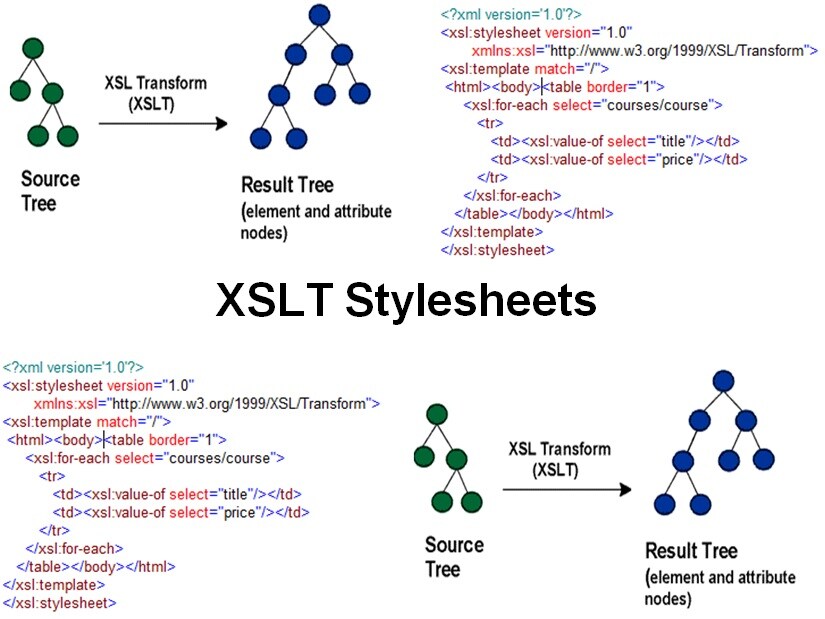-
Learning by doing
-
Trainers with practical experience
-
Classroom training
-
Detailed course material
-
Clear content description
-
Tailormade content possible
-
Training that proceeds
-
Small groups
The course XSLT Stylesheets discusses how XSLT, eXtensible Stylesheet and Transformation Language can be used to format and transform XML documents. The course is based on the latest version of XSLT but the differences with previous versions are also highlighted.
The course deals with transformations from XML to HTML, from XML to XML and from XML to other text formats such as plain text and JSON.
Furthermore, attention is paid to navigating through XML documents via XPath expressions and the various search axes of XPath are explained.
There is plenty of attention for the many functions that XPath and XSLT have to offer and that can be called during the transformation process.
An important element of XLST is the principle of template matching. This therefore forms the central element of the course.
The XSLT elements that have to do with flow control are discussed, as well as those for copying elements.
Furthermore, the use of generic templates and the use of apply templates is discussed as well as named templates and their calling with call-template.
The transformation of attributes to elements and vice versa is also on the course schedule.
Finally, we look at transformations from XML to various other formats. In this respect, a separate module is devoted to the transformation language XSL-FO and transformations to PDF.
The course XSLT Stylesheets is intended for Application developers, Web developers and project managers who want to learn XSLT to apply XML formatting and transformation.
Knowledge of HTML and XML syntax is required. Knowledge of the basic concepts of programming is not required but beneficial.
The theory is discussed on the basis of presentation slides. The theory is clarified using demos and interspersed with exercises. The course material is in English. The course times are from 9.30 up and to 16.30.
Participants receive an official certificate XSLT Stylesheets after successful completion of the course.

Module 1 : XSL Intro |
Module 2 : Transformation to HTML |
Module 3 : XPath |
| The XSL Family What is XSLT? What is XPath? XSL's Position XSLT Stylesheets XSLT Versions StyleSheet Blueprint The XSLT Vocabulary Template Rules Default Templates XSLT Document Structure xsl:output XSLT Processors Processors Implementations |
Adding Stylesheets Extracting Values from XML Navigating the XML Document Using Predicates Iterating through XML Elements Creating HTML Tables Absolute and Relative Path Conditional Processing Accessing Document Parts ..// Operator Access XML Data with Nodelists Internal hyperlinking Numbering Sorting |
XPath Expressions XPath Node Types XPath Context Location Path Syntax XPath Axes Predicates XPath Operators XPath Functions Node Tests in XPath XML Schema Data Types Sequences For Expressions Conditional Expressions Namespace Nodes |
Module 4 : XSLT Variables |
Module 5 : XSLT and XPath Functions |
Module 6 : Transformation to XML |
| xsl:variable xsl:variable with Subtree Working of xsl:variable Variable Scope Global Variables Changing Variables Tracing Output xsl:param Passing Parameters to Templates Named Templates Calling Templates Call by Reference |
Numeric Functions String Functions Boolean Functions Accessor Functions Node Functions Sequence Functions Any Uri Functions Context Functions Duration and Time Functions Error and Trace Functions QName Functions Regular Expression Functions |
Transformation Language xsl:element Selecting all Elements Selection all Attributes name function xsl:attribute Copying Elements Generalization Multiple Applicable Rules mode attribute xsl:include xsl:import |
Module 7 : Transformation to Text |
Module 8 : Advanced XSLT |
Module 9 : XSL-FO |
|
Text Formats Plain Text Files CSV files Transforming JSON Handling Entity References White Space Handling xsl:space Preserving space xsl:preserve-space Stripping Space xsl:strip-space |
Using Typing Strong Typing XML Schema Validation Temporary Trees User-Defined Functions Grouping by Value Grouping in Sequence Multiple Result Trees Output Serialization Character Mapping Character Substitutions |
What is XSL-FO? XSL-FO Documents Layout Master Set Page Sequence Masters Page Template Layout XSL-FO Areas XSL-FO Pages Static Content Flows Page Sequences Tree for Pagination |
